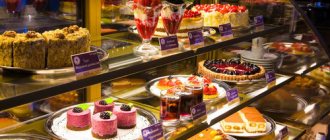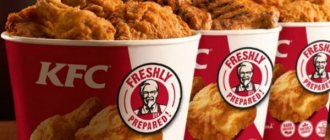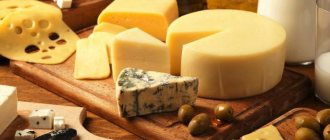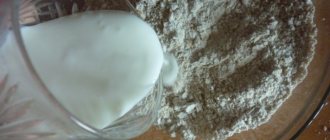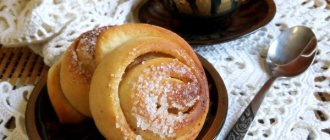Latte is a hot, layered coffee, medium-calorie drink made from 1 serving of espresso, milk and milk foam. Italy is considered the birthplace of the drink.
It was there that Italian housewives, to please children who wanted to be like their parents who drank coffee in the morning, diluted the strong drink with milk, “staining” it a little. The word “stained” is where the name “latte” comes from, which later became one of the most popular drinks in Europe.
Kinds
Latte without sugar (the calorie content of the drink when using 2.5% milk is no more than 93 kcal) is a popular coffee drink in Europe. Unlike cappuccino, latte according to the classic recipe is prepared from 1 portion of espresso (30-50 ml) and 4 portions of milk, as a result of which the drink has a pleasant sweetish creamy milky taste and low strength.
In modern coffee shops, a variation is more common, in which 80 ml of espresso (2 servings) and 4 servings of milk (120-150 ml) are used. This drink has a strong strength and is suitable for lovers of coffee and milk mixtures, decorated with abundant foam.
When preparing, coffee is poured into the whipped, loose milk foam in a thin stream, then syrup is added if desired and decorated with cinnamon or chocolate chips.
There are several types of milk-coffee drink:
- Cinnamon , in which cinnamon powder or stick is added to garnish the foam;
- With syrups . Syrups add sweetness to the latte and are added to the glass before foaming the milk. Vanilla, caramel, and nut syrups are best suited for this drink. It is not advisable to take fruit ones, as they can cause fermentation of the milk mixture.
- Vanilla. Prepare with the addition of a vanilla bean (or vanillin) when whipping the milk mixture.
- Caramel . Requires the use of caramel syrup or caramel added to the whipped milk.
- With ice cream . A traditional recipe in which an additional scoop of vanilla ice cream is added to the coffee and milk mixture.
- Autumn . A fashionable option used for Halloween. Consists of adding pumpkin puree to the drink for decoration.
- Black latte . A recipe developed by nutritionists and requiring a replacement for coffee 1 tab. activated carbon.
How do milk and sugar affect the energy value of coffee?
Once upon a time, the most popular drink in Russia was tea, and it actually remains so to this day. But in the near future he will have to share the palm with coffee. Tea consumption per capita in Russia is now 1.4 kg per year, while coffee is 1.7 kg. Naturally, this is not the highest figure in the world, yet the numbers indicate the popularity of this drink in our country.
Who among us has not resorted to this strategy: in order to save time and avoid unnecessary calories, we skip breakfast and reinforce ourselves on the way to work with a cup of coffee with milk and, of course, without sugar? With all this, we have hopes that such a diet may not help you lose weight, but at least it will prevent the occurrence of extra pounds.
But regular calorie counting leaves no stone unturned in maintaining the weight loss strategy. Don't believe me? Check it out for yourself. For example, a sandwich made of dark bread with butter and jam for breakfast contains 172 Kcal, and drinks with caffeine and various additives - up to 200 Kcal.
Basically, coffee itself contains virtually no calories. Depending on its type, the calorie content of the drink is 2-4 Kcal. Ingredients such as whole milk, cream, sugar and various flavorings and fillers add energy value to the drink. They ferociously turn coffee drunk instead of breakfast into a real calorie-rich dessert.
Still, those who cannot give up their morning cup of coffee can simply balance its calorie content with the amount of milk, cream or sugar, a serving of which contains 14, 19 and 16 calories, respectively. So, the calorie content of 100 grams of coffee with milk without sugar is no more than 20 Kcal.
Calorie content, BJU
The calorie content of a sugar-free latte directly depends on the fat content of the milk used for its production. The approximate energy value of a latte made from espresso and milk with 2.5% fat is about 90-93 kcal.
Latte without sugar. Calorie content and ratio of BZHU.
Composition of the product:
| Squirrels | 5 gr. |
| Fats | 5.4 gr. |
| Carbohydrates | 8.9 gr. |
| Alimentary fiber | 0 |
| Water | 0 |
The original recipe requires adding fatty dairy products to the drink, complementing the taste with a variety of syrups, which significantly increases the calorie content of the milk-coffee mixture. The calorie content of lattes served in various establishments is slightly higher than at home due to the use of higher fat milk (3.2%), various syrups and decorations.
| McDonald's | energy value | 125 kcal |
| squirrels | 6 gr. | |
| fats | 7 gr. | |
| carbohydrates | 10 gr. | |
| Starbucks (plain latte) | energy value | 119 kcal |
| squirrels | 26 gr. | |
| fats | 6.7 gr. | |
| carbohydrates | 11 gr. | |
| Caramel Apple Latte | Energy value | 280 kcal |
| Walnut Ginger Latte | 270 kcal | |
| Gingerbread | 320 kcal | |
| CoffeeHouse (low fat) | Energy value | 73 kcl |
| squirrels | 4 gr. | |
| fats | 1.6 gr. | |
| carbohydrates | 6 gr. | |
| Coffee Bean, vanilla | Energy value | 210 kcal |
| squirrels | 15 gr. | |
| fats | 6.2 gr. | |
| carbohydrates | 20 gr. | |
| Coffee mania | Energy value | 156 kcal |
| squirrels | 7 gr. | |
| fats | 5 gr. | |
| carbohydrates | 15 gr. | |
| Late ice (milk 2.5% fat) | Energy value | 77 kcal |
| squirrels | 4.3 gr. | |
| fats | 5 gr. | |
| carbohydrates | 6.9 gr. |
Since the caloric content of the product increases significantly depending on the fat content of milk and sweet additives during dietary nutrition, it recommends drinking only a simple latte without syrups, chocolate chips and sugar.
A latte prepared using a coffee machine has a calorie content of 62 kcal, since it is prepared using a small volume of milk (about 100-120 ml) with a fat content of 2.5%, which is 52 kcal per 100 g. and low-calorie espresso, which has virtually no contact with water.
You can independently calculate the calorie content of a creamy coffee drink by taking the number of calories contained in the milk used, dividing them by 100 and multiplying by the desired volume. So if in a 240 ml glass there is about 180 ml of milk with a fat content of 2.5%, it means: the calorie content of the latte will be: 52/100*180=93.6 kcal.
Useful elements found in latte:
| Vitamins |
|
| Micro- and macroelements |
|
| Omega-6 | 32.5 mg |
Energy value of one cup
Natural grain and ground products hold the record for low calorie content. How to calculate how many calories are in natural coffee? A 100 ml drink from a grain product brewed using the usual method will contain 1-2 kilocalories. This refers to the calorie content of coffee without sugar. Therefore, a mug of coffee that is 200 ml will contain a maximum of 4 kcal. The calorie content of ground coffee is even lower - only 2 units per 200 ml.
The less water in one serving, the greater its energy value. Therefore, when choosing between espresso and Americano, it is better to give preference to the second.
Benefit
A latte without sugar (the calorie content of the product is given in the article), due to the high milk content, supplies the body with a large amount of the “joy hormone”, which banishes drowsiness and helps fight the consequences of stressful situations.
Among the useful qualities of the product:
- good invigorating effect;
- assistance in restoring strength after suffering serious physical and mental stress;
- weakening of the severity of the manifestation of VSD and accompanying migraine;
- stabilization of potency;
- reducing the risk of developing cancer, Parkinson's disease and liver cirrhosis;
- replenishing the body with calcium and fluorine, which are responsible for the good condition of bones and teeth;
- regulation of the gastrointestinal tract, restoration of intestinal microflora;
- assistance in the treatment and prevention of cardiovascular pathologies;
- as a natural antioxidant reduces the negative impact of free radicals on the body's cells.
A large amount of milk prevents the negative qualities of pure espresso because:
- preventing the aggressive effect of gastric juice, intensely produced under the influence of caffeine, on the walls of the esophagus;
- preventing the leaching of calcium and the antioxidant complex from the body.
Latte is useful for pregnant women, especially those who cannot imagine their day without a cup of coffee. The caffeine contained in the product will help you wake up and invigorate, and a large amount of milk will compensate for the lack of nutrients and prevent an increase in acidity (caused by caffeine) in the body.
Harm
In addition to its beneficial qualities, the caffeine contained in latte has a stimulating effect on the nervous system, which can cause insomnia in overly sensitive people. Drinking coffee drink also negatively affects the condition of tooth enamel, causing the appearance of yellow plaque.
Dentists strongly recommend performing oral hygiene after every cup of coffee you drink.
In case of improper (use of artificial milk substitutes, low-quality grains) or excessive consumption of the drink, indigestion, heartburn, and stool disorders may occur. A very large amount of drink can cause high blood pressure, depression of the nervous system, osteoporosis or stomach cancer.
In addition to dangerous consequences, large doses of caffeine cause addiction, which upon withdrawal provokes:
- headache;
- depression;
- disturbance of consciousness;
- tachycardia.
Menu for diet
While on a diet, you can only drink a latte that you prepare yourself (preferably using a coffee machine, but you can use whole coffee beans), without adding sugar or syrups. Only skim or 2.5% fat milk is used.
This drink, unlike natural coffee without additives, is not the basis of mono-diets or fasting days, but is included in the diet for consumption in the morning or as a snack, since it perfectly dulls the feeling of hunger and gives the body the energy necessary for work and sports.
Diet rules:
- The diet includes only low-calorie foods, such as low-starch vegetables and fruits, fermented milk products, cereals, lean meats, fish and poultry.
- It is prohibited to consume fatty foods, confectionery, sugar, carbonated drinks, smoked sausages and fast food.
- Latte for a diet is prepared only independently from whole coffee beans with the addition of medium-fat (2.5%) milk. Lattes from Starbucks or McDonald's should not be used on a diet due to the large amount of sweet ingredients they contain.
- You should drink a coffee drink in the morning (for breakfast) or as a snack, no more than 3 times a day. Latte is prepared without the use of syrups, ice cream, or sugar. For taste, you can add cinnamon or nutmeg.
- In addition to latte, during the diet you should drink at least 1.5 liters of mineral (non-carbonated) water and green tea.
You should stick to the diet for at least 7 days. If well tolerated, it is allowed to extend the diet up to 10-14 days.
Diet menu:
| 1st day | |
| Breakfast |
|
| Snack |
|
| Dinner |
|
| snack |
|
| Dinner |
|
| 2nd day | |
| Breakfast |
|
| Snack |
|
| Dinner |
|
| Snack |
|
| Dinner |
|
| 3rd day | |
| Breakfast |
|
| Perex |
|
| Dinner |
|
| Perex |
|
| Dinner |
|
| 4th day | |
| Breakfast |
|
| Snack |
|
| Dinner |
|
| Snack |
|
| Dinner |
|
| 5th day | |
| Breakfast |
|
| Snack |
|
| Dinner |
|
| Perex |
|
| Dinner |
|
| 6th day | |
| Breakfast |
|
| Snack |
|
| Dinner |
|
| Snack |
|
| Dinner |
|
| 7th day | |
| Breakfast |
|
| Snack |
|
| Dinner |
|
| Snack |
|
| Dinner |
|
In a week of such a diet you can lose from 3 to 5 kg.
According to traditional Italian rules for "spotted drink":
- Served in tall transparent glasses through which the layers of milk, coffee and foam are clearly visible. First, the milk mixture is poured into the glass, then coffee is added carefully so as not to damage the layer. The last thing to lay out is loose creamy foam.
- A latte is prepared from roasted coffee beans and high-fat milk, whipped with a cappuccino maker in a special metal jug.
- The syrup should be poured in a thin stream until foam is applied, since it should settle at the bottom of the glass.
- The foam for a latte should be loose and not fluffy, so it is made from milk, not cream, unlike cappuccino. You can decorate it with cocoa powder, chocolate chips or cinnamon. Drawings on foam are allowed.
- The drink must be served with a long, wide straw and brown lump sugar.
Unlike cappuccino, whose calorie content is significantly higher than that of latte due to the large amount of cream added. Latte is prepared strictly without sugar from full-fat milk, added before, and not after (as in cappuccino) pouring in the coffee.
Latte foam should be loose, without large bubbles, which is especially welcome in cappuccino. The drink is given a special originality by the ornament created on the surface of the foam, decorated with cinnamon, nutmeg or chocolate inclusions.
Instant coffee
Depending on the variety and type of instant coffee, this drink may have different calorie content, but it ranges from approximately 5 to 7 calories per 100 ml of finished drink.
If possible, it is better to brew a natural version rather than using instant coffee. The natural product contains much more essential substances.
Depending on what ingredients were used and how the latte was prepared, its calorie content without added sugar will be approximately 100 eighty to two hundred and fifty calories per standard two hundred ml cup.
Thus, 100 ml of latte contains ninety - 100 20 5 calories per 100 ml of finished drink.
This type of coffee is quite high in calories, and the cream contains quite a lot of fat, which means that latte is not very suitable for weight loss.

